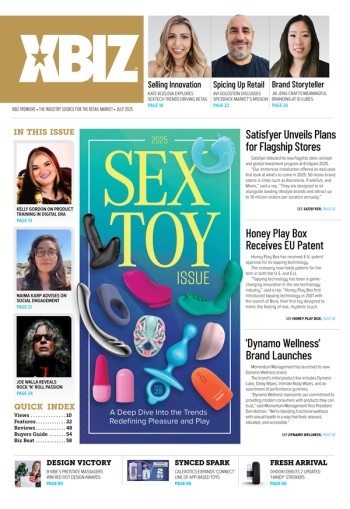If New York City resident Chuck Mueller had owned a crystal ball when he opened The Leather Man back in June 1965, he would have been pleasantly surprised to learn that his West Village store (which has a largely gay clientele and specializes in leather fetish attire and BDSM items) would still be in business 48 years later. Indeed, a lot of things about 2013 probably would have surprised Mueller if he had looked into a crystal ball in 1965: the fact that many politicians are openly supporting gay marriage, the fact that a black man was decisively re-elected to a second term as president of the U.S., the fact that BDSM (at least a lighter version of it) has become so mainstream that floggers and ballgags are popping up on sitcoms and Top 40 singers like Rihanna are singing that “whips and chains excite me.” It was a different world in 1965. But in fact, The Leather Man (TheLeatherMan.com) is still going strong in 2013 — and it is no exaggeration to describe the store as a West Village institution.
From the beginning, The Leather Man catered to leather fetishists. Many of the store’s early customers were leathermen (gay men in the BDSM scene known for wearing a lot of black leather). Eric Watkins, who has been with the store since 1990 and is now its co-owner, director and general manager, recalled that Mueller opened The Leather Man “with one sewing machine, some leather hides, and samples of each of his available patterns for customers to select. Originally, all items were made to order, one piece at a time — and only leather clothing was available.”
As the services and selection of merchandise have grown, so has the diversity of our customers. -Eric Watkins, Co-Owner of The Leather Man
The Leather Man has always been on Christopher Street, although it hasn’t always been at its current location of 111 Christopher St. The original location was at 85 Christopher St., which wasn’t far from the famous Stonewall Inn at 53 Christopher St. In 1969, the Stonewall Inn (a gay bar) became a symbol for gay rights when a police raid on that establishment was followed by some very angry, heated protests and demonstrations. Watkins pointed out that The Leather Man preceded the Stonewall rebellion by four years.
“The Leather Man opened as a gay-owned and operated NYC fetish business four years prior to the Stonewall riots, widely considered to be the single most important event leading to the gay liberation movement and the modern fight for gay and lesbian rights in the United States,” Watkins explained. “Up until the riots, openly gay NYC businesses and residents were often targeted and harassed by authorities, including arrest. The Leather Man was actively involved in the fight for gay rights throughout the 1960s and 1970s.”
After moving from 85 Christopher St. to 111 Christopher St. in the early 1970s, the store continued to grow and expand. Watkins noted: “By the end of the 1970s, Chuck was offering more of the fetish gear that his customers desired, incorporating a vast selection of pornography and adult toys to round out the store’s selection, mainly for gay leathermen.”
Although The Leather Man has had a largely gay, BDSM-minded clientele over the years, not all of its customers fit that description. Straight men in New York City’s BDSM scene have, for decades, been drawn to The Leather Man because of the store’s impressive selection of leather attire, restraints, instruments of discipline (whips and floggers, canes, paddles, riding crops) and kinky sex toys. And some of The Leather Man’s customers, both gay and straight, have been people who love the look and feel of leather but aren’t necessarily major BDSM players.
Asked roughly what percentage of The Leather Man’s customers are gay and what percentage are straight, Watkins replied: “The Leather Man’s customer base is certainly much broader and more diverse than at any point in the store’s history. While the highest percentage of our customers would identify as gay men, we do not track such demographics. So it is hard to give precise statistics.”
Watkins added: “As the services and selection of merchandise have grown, so has the diversity of our customers. It is difficult to quantify percentages, as we do not ask our customers which demographics they may belong to. We are primarily a store catering to the needs of the leather/BDSM/fetish community, but our appeal and reach is much broader. The reputation of our leather clothing brings us a wide customer base, some of whom are more concerned about fashion than fetish. In a similar way, we are popular with bikers who want good quality riding leathers — and we are increasingly busy working with magazines, websites, film, television, fashion and music industries.”
Mueller retired from operating The Leather Man in the early 1990s, when he turned the operation of the store over to Watkins. However, Mueller is still the company’s president and principle owner. Another key figure at The Leather Man is Max Gregory, who came on board in 1995 and now serves as store manager and buyer. Gregory, according to Watkins, “continues to be a driving force in the day-today running of the store, the face of The Leather Man on the road at leather events, and a vital part of the leather/BDSM/fetish community at large.”
Another thing Mueller would have been shocked to see if he had owned a crystal ball back in 1965 was how radically gentrified New York City would become in the 1990s and beyond. Indeed, the Christopher Street of the 1960s and 1970s was much edgier than the West Village of 2013.
“The West Village has changed dramatically during the store’s existence,” Watkins observed. “Today, Christopher Street is no longer the ‘gay ghetto’ or Bohemian artist community it once was. It is more diverse and family- oriented and has recently been reported as one of the most expensive zip codes in the country. In recent years, the West Village has seen the influx of many designer flagship stores, which now occupy many of the storefronts on Christopher Street as well as on surrounding streets. While rising rents and operating costs pose definite challenges, the economic and demographic changes have also brought many new customers, allowing The Leather Man an opportunity to serve the needs of our neighbors, both new and old.”







